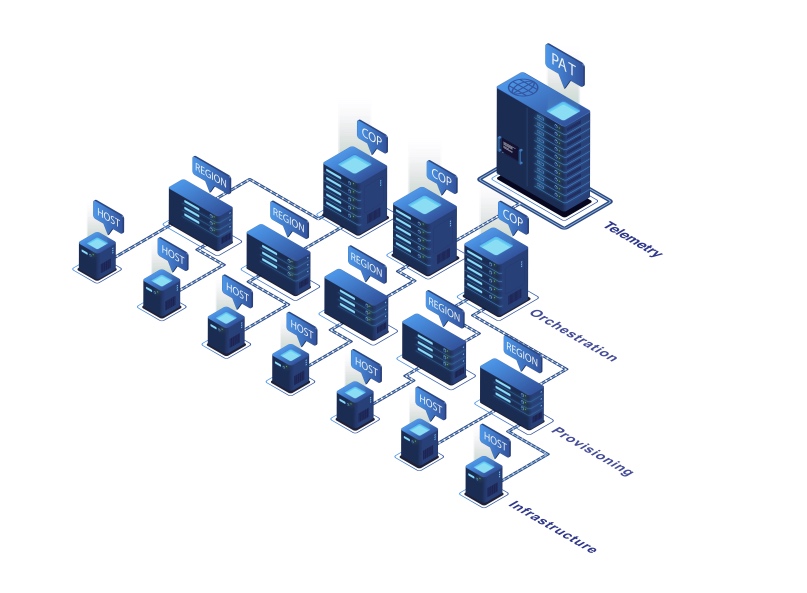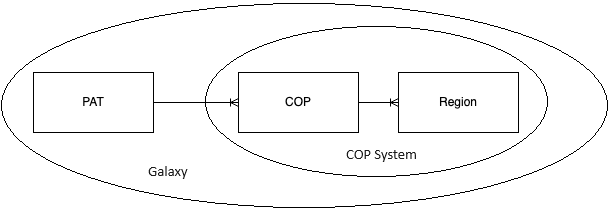Hardware Pods, Flavors and Blends¶
Pods¶
Click the link below to watch an introductory video on CloudCIX architecture…
CloudCIX is installed in hardware units called Pods.
Software Flavors¶
The software running in a Pod has three flavors, PAT, COP and Region. To allow bitwise based branching in the software these flavors are represented by the following integers.
PAT Flavor = 1
COP Flavor = 2
Region Flavor = 4
You can think of these software favors as adding functionality to a Pod.
Pod Blends¶
A Pod runs a combination of these flavors called a blend. Four blends are allowed/supported.
The COP blend contains the COP flavor only and it is represented by blend 2
The Region blend contains the region flavor only and it is represented by blend 4
The COP Region blend contains the COP and Region flavors and it is represented by blend 6
The PAT blend contains PAT, COP and Region flavors and is therefore represented by blend 7
Blend 2 Pod. COP (Central Orchestration Platform)¶
A COP is a Pod that hosts the Cloud metadata and provides the UI and API for one CloudCIX instance. One COP can manage multiple Regions. A COP plus the Regions it manages is referred to as a CloudCIX Galaxy.
Blend 4 Pod. Region¶
A Region is a Pod that takes declarative instructions, via na API, from the COP and is responsible for building the user required infrastructure. A Region contains the hosts providing compute and storage. It is intended that Regions be geographically distributed for resilience, data sovereighty and latency reduction reasons.
Blend 6 Pod. COP-Region¶
This would be used if you wanted to isolate the COP metadata and only needed one Region.
Blend 7 Pod. PAT (Provisiong and Telemetry)¶
A PAT is a Pod type that has the COP and Region flavors installed plus some extra functionality to allow it provision, adopt and provide telemetry services to other Pods. Although the projects built in a PAT are ordinarily intended to be used to provide Telemetry processes to other Pods, it is possible to build projects for any purpose in a PAT. For that reason, a PAT Pod can be used as a fully functional, stand alone, single region private Cloud. A PAT plus the Cops and Regions it orchestrates is referred to as a Universe.

Note
Since a PAT is really a COP and a Region, you can think of a PAT as a Cloud that hosts provisioning and telemetry systems to manage other Clouds that themselves comprise COP and Region Pods.
Every Pod comprises three types of host.
The CloudCIX Appliance is a host running the software for that Pod. Software is installed as Docker images and each flovour has a different subset of containers.
PodNet provides the network functionality for the Pod. PodNet implements routing, firewall and VPN functionality for the Pod.
Hosts under the control of the Pod Appliance are then added to the Pod as required. These Hosts contain the workloads of the Pod.
Pods working together¶
Astrophysics analogies are sometimes used to describe how groups of PODs work together.
All instances on CloudCIX are referred to as the Universe.
Each group of Pods managed by one PAT is called a Galaxy.
A COP and the Regions it manages are called a COP system (think Solar system).
If it helps, you can think of each host as a planet.

Functionality of Pod flavors¶
We will look in more detail at the functionality of the PAT, COP and Region Pods.
PAT
A PAT (Provisioning and Telemetry) Pod contains the tools necessary to deploy, update and monitor one or more CloudCIX Galaxies. A single PAT and the Galaxies is manages are referred to as a Universe.
COP
Every CloudCIX COP (Central Orchestration Platform), exposes a microservices API. All instances of CloudCIX use the same code base. However, based on performance requirements, this code base can be executed on hardware platforms of varying performance. A COP implementation can vary from a single server running Docker images for all of the components to a multiple physical server implementation where each of the many components run on dedicated hardware.
Region
Customer infrastructure is built in Region Pods. Each Customer can have multiple Projects, each Project containing Cloud resources that meet a specific Customer requirement. Each Project in a CloudCIX Region uses a separate virtual router (VR) on PodNet to ensure total project separation. Each Project has one or more Private Networks. Each Project can implement zero or more Site to Site VPN tunnels.
Minimum Hardware Requirements of Pod Hosts¶
Host vs Blend |
COP |
Region |
COPRegion |
PAT |
|---|---|---|---|---|
Podnet |
|
|
|
|
Appliance |
|
|
|
|
KVM |
NA |
|
|
|
HyperV |
NA |
|
|
|
Ceph Monitor |
NA |
|
|
|
Ceph |
NA |
|
|
|